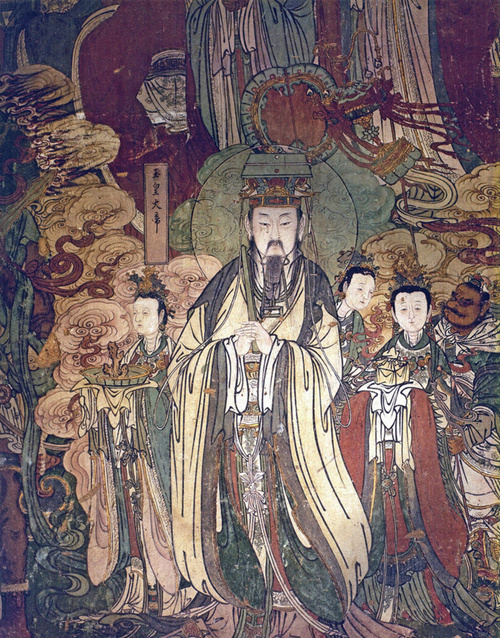The mysterious murals of Pilu Temple
Author : CHANG CHEN Source : Chinese Social Sciences Today 2017-05-17

The Jade Emperor in the mural wears yellow and green, which is distinct from the traditional Chinese style of portrait and makes a deep impression on visitors.
Pilu Temple has a history of more than 1,200 years. The murals of its inner sanctum represent a cultural legacy left by our ancestors. The murals are a precious pearl set on the crown of mural art and are often called a typical representative of oriental art.
The temple, known for its exquisite ancient murals, is located at Shangjing Village in the northwest suburbs of Shijiazhuang City, Hebei Province. It is recorded that the temple was established in the Tang Dynasty, but the existing murals, themed on shuilu, were painted in the Ming Dynasty. Shuilu, literally meaning water and land, refers to the ritual paintings which were originally introduced by Buddhism from India during the Wei and Jin dynasties. In the temple, 508 figures of shuilu paintings were drawn on the 140-square-meter walls, and these portraits inherited Tang famous painter Wu Daozi’s painting style. Although thousands of years have passed, the murals retain vivid colors and strong three-dimensional characteristics.
The exquisite style of the temple murals integrates the religious elements and ideas of Buddhism, Taoism and Confucianism as well as social customs and ancient figures. Artisans utilized the techniques of exact delineation and application of enriched colors to design the murals. They had rich experience in translating figures into fine lines and exquisite shapes. Various lines precisely showed the tiny changes and differences between figures and gave the portraits a vivid effect. For example, artisans’ paintbrushes successfully captured figures’ clothes dancing in the wind, which realized the harmony and balance between dynamic and static elements. The application of bold and bright colors—vermilion, mineral green, mineral yellow, black, brown and blue—added splendid styles to the murals.
The murals on the Jade Emperor, the supreme deity of Taoism and emperor of the immortal world, are very lifelike. On the murals, the emperor wears royal official clothes and has a serene appearance, giving people a sense of sincerity and kindness. The generals of heaven arrayed behind the emperor look mighty and the maids are humble. It is said that these murals were drawn by Tang Bohu, a famous painter in the Ming Dynasty, attracting many fans of the artist to visit them throughout the history. Indeed, Tang’s style is reflected in the murals. For example, figures in the murals wear yellow and green instead of traditional Chinese red and green, which give people an impression of elegance, free from vulgarity.
Ye Shengtao made Chinese fairy tales from a wilderness
Ye Shengtao (1894–1988) created the first collection of fairy tales in the history of Chinese children’s literature...
-
How northern ethnicities integrated into Chinese nation
2023-09-18
-
Mogao caves
2023-09-12
-
Mogao Grottoes as ‘a place of pilgrimage’
2023-09-12
-
Time-honored architectural traditions in China
2023-08-29
-
Disentangling the civilizational evolution of China
2023-08-28
-
AI ethics in science fiction
2023-08-23














 2011-2013 by www.cssn.cn. All Rights Reserved
2011-2013 by www.cssn.cn. All Rights Reserved